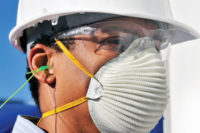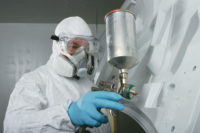OSHA requires that in any workplace where respirators are necessary to protect the health of the employee or whenever respirators are required by the employer, a written respiratory protection program must be established and implemented.
The program includes procedures specific to each worksite and is intended to prevent employees from inhaling harmful contaminants. Specifically, each employer must provide respirators to protect workers from workplace hazards to prevent inhalation of hazardous materials that cannot be controlled by other measures (i.e., engineering or administrative controls).
Respirators must also be provided to ensure that employees do not breathe air that contains dangerously low levels of oxygen or that is otherwise immediately dangerous to life or health (IDLH).
Keep in mind that these respiratory hazards are something that employees could be exposed to during:
- Normal operating conditions, and
- Reasonably foreseeable emergencies.
- Follow these steps to set up an effective and compliant respiratory protection program.
Step one — Designate a respiratory protection program administrator
Employers must designate a respiratory program administrator to run their program. This is typically a safety officer and in the best of cases, an industrial hygienist. Whoever you appoint, this person must be:
- Trained to identify, assess, and control types of potential inhalation hazards in your work area.
- Familiar with OSHA’s Respiratory Protection Standard (29 CFR 1910.134) and the use and application of the respirators at the workplace.
- Responsible for ensuring employees are provided with an appropriate and suitable respirator at no cost to them.
Designating the program administrator first allows that person to help develop the written respiratory protection plan.
Step two — Develop a written respiratory protection plan
OSHA requires that each respiratory protection program include a written plan detailing how the program will be administered. OSHA requires the respiratory program be in writing because health and safety programs are almost always more effectively implemented and evaluated when the procedures are in a written form. In addition, putting it in writing ensures employers will thoroughly assess and document information pertaining to respiratory hazards.
Make sure the written plan includes:
- Procedures for selecting respirators
- Medical evaluation of employees required to wear respirators
- Fit testing procedures for tight fitting respirators
- Procedures for proper use of respirators in routine and reasonably foreseeable emergency situations
- Procedures and schedules for cleaning, disinfecting, storing, inspecting, repairing, and discarding and otherwise maintaining respirators
- Procedure to ensure adequate quality, quantity, and flow of breathing air for atmosphere-supplying air respirators
- Training of employees in the proper use of respirators, including putting on and removing them, and any limitations on their use and their maintenance
- Procedures for regularly evaluating the effectiveness of the program
- Procedures for ensuring that workers who voluntarily wear respirators (excluding filtering facepieces) comply with the medical evaluation, and cleaning, storing, and maintenance requirements of the standard
Step three — Ensure the program is enforced
In addition to having a written plan, the employer must demonstrate that it’s enforced. It may be rare that an employee doesn’t follow their company’s respiratory protection requirements, but it can happen.
Ensure the employee has received proper training in the need for, and use of, respiratory protective equipment. Talk with the employee to verify understanding of the training and provide refresher training as needed.
If the employee continues to not follow the company policy, then implement graduated disciplinary procedures. These could include:
- Verbal warning for first offense
- Written warning for the second offense
- Termination of employment for the third offense
Step four — Review and update the program
Once the respiratory protection program been implemented the employer will want to determine how effective it is. Ask these questions:
- Are affected employees following the program?
- Have there been any respiratory injuries or illnesses since the program was implemented or last reviewed?
- Have there been employee suggestions for engineering controls that would no longer necessitate the need for respiratory protection?
Review and update the program as necessary to reflect changes in respiratory hazards in the workplace. For example, if new processes or chemicals are introduced into the workplace that could impact respirator use, revise the applicable parts of the written program. Another reason to update the program is if there were changes in the types of respirators used. Finally, make sure these revisions are communicated and implemented.
Setting up a respiratory protection program can be a daunting task. But, by following these four steps, employers can catch their breath and not worry if OSHA stops by for a visit.



